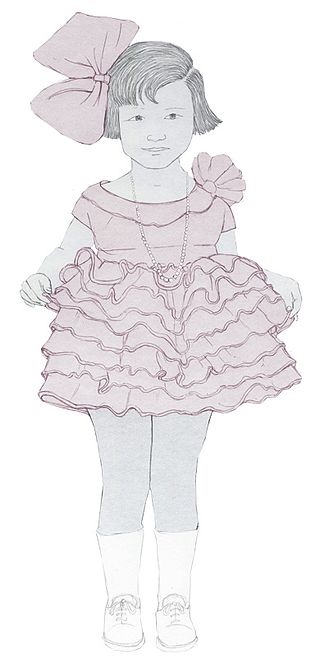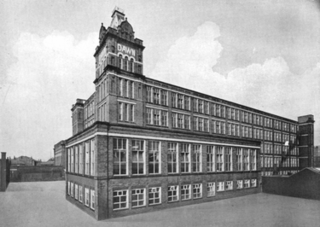Related Research Articles

Textile is an umbrella term that includes various fiber-based materials, including fibers, yarns, filaments, threads, different fabric types, etc. At first, the word "textiles" only referred to woven fabrics. However, weaving is not the only manufacturing method, and many other methods were later developed to form textile structures based on their intended use. Knitting and non-woven are other popular types of fabric manufacturing. In the contemporary world, textiles satisfy the material needs for versatile applications, from simple daily clothing to bulletproof jackets, spacesuits, and doctor's gowns.

Muslin is a cotton fabric of plain weave. It is made in a wide range of weights from delicate sheers to coarse sheeting. It gets its name from the city of Mosul, Iraq, where it was first manufactured.

Poplin, also called tabinet, is a fine wool, cotton or silk fabric that has a vertical warp and a horizontal weft. Nowadays, the name refers to a strong material in a plain weave of any fiber or blend, with crosswise ribs that typically give a corded surface.
A mill town, also known as factory town or mill village, is typically a settlement that developed around one or more mills or factories, usually cotton mills or factories producing textiles.

Twill tape or twilled tape is a flat herringbone twill-woven fabric tape or ribbon of cotton, linen, polyester, or wool. It may be used in sewing and tailoring to reinforce seams, make casings, bind edges, and make sturdy ties for closing garments. Twill tape is also used in theatre to tie curtains, cable and scenery to various objects, or to tie cable coils so that they do not unroll.

Crêpe, also spelled crepe or crape is a silk, wool, or synthetic fiber fabric with a distinctively crisp and crimped appearance. The term "crape" typically refers to a form of the fabric associated specifically with mourning. Crêpe was also historically called "crespe" or "crisp".

Candlewicking, or candlewick is a form of whitework embroidery that traditionally uses an unbleached cotton thread on a piece of unbleached muslin. It gets its name from the nature of the soft spun cotton thread, which was braided then used to form the wick for candles. Motifs are created using a variety of traditional embroidery stitches as well as a tufted stitch. Subject matter is usually taken from nature—flowers, insects, pine trees, and so on, Other traditional motifs resemble Pennsylvania Dutch or Colonial American designs. Modern designs include colored floss embroidery with the traditional white on white stitching.

Sateen is a fabric made using a satin weave structure, but made with spun yarns instead of filament.

Taffeta is a crisp, smooth, plain woven fabric made from silk, cuprammonium rayons, acetate, or polyester. The word came into Middle English via Old French and Old Italian, which borrowed the Persian word tāfta (تافته), which means "silk" or "linen cloth". As clothing, it is used in ball gowns, wedding dresses, and corsets, and in interior decoration for curtains or wallcovering. It tends to yield a stiff, starched-like cloth that holds its shape better than many other fabrics and does not sag or drape.
Dowlas was a strong coarse linen cloth of the 16th and 17th centuries, and initially, it was manufactured in Brittany. In the 18th century the fabric was also produced in England and Scotland. Dowlas was identical to sailcloth. The cloth was also imitated in cotton for the same use.

Broadcloth is a dense, plain woven cloth, historically made of wool. The defining characteristic of broadcloth is not its finished width but the fact that it was woven much wider and then heavily milled in order to shrink it to the required width. The effect of the milling process is to draw the yarns much closer together than could be achieved in the loom and allow the individual fibres of the wool to bind together in a felting process, which results in a dense, blind face cloth with a stiff drape which is highly weather-resistant, hard wearing and capable of taking a cut edge without the need for being hemmed.

Organdy, also spelled Organdie, is a kind of sheer fabric. It is a lightweight balanced plain weave cotton with features of sheerness and crispness.

A justacorps or justaucorps is a knee-length coat worn by men in the latter half of the 17th century and throughout the 18th century. The garment is of French origin, and was introduced in England as a component of a three-piece ensemble, which also included breeches and a long vest or waistcoat. This ensemble served as the prototype of the frock coat, which in turn evolved into the modern-day three-piece suit.

Shot silk is a fabric which is made up of silk woven from warp and weft yarns of two or more colours producing an iridescent appearance. A "shot" is a single throw of the bobbin that carries the weft thread through the warp, and shot silk colours can be described as "[warp colour] shot with [weft colour]." The weaving technique can also be applied to other fibres such as cotton, linen, and synthetics.

Herringbone, also called broken twill weave, describes a distinctive V-shaped weaving pattern usually found in twill fabric. It is distinguished from a plain chevron by the break at reversal, which makes it resemble a broken zigzag. The pattern is called herringbone because it resembles the skeleton of a herring fish. Herringbone-patterned fabric is usually wool, and is one of the most popular cloths used for suits and outerwear. Tweed cloth is often woven with a herringbone pattern.

Dawn Mill, Shaw was a cotton spinning mill in Shaw and Crompton, Oldham, Greater Manchester. It was built on the site of Shaw Mill at the "dawn" of the 20th century. Dawn Mill was equipped with mule weft spindles in 1950. It was powered by Engines named Venus and Mars, 1800 hp twin tandem compound engine by George Saxon of Manchester. It was taken over by the Lancashire Cotton Corporation in the 1930s and passed to Courtaulds in 1964. It was sold again and used by distribution company DTS Logistics for storing and distributing clothing. It was demolished in 2006 to make way for an Asda supermarket.

Elm Mill, was a four-storey cotton spinning mill in Shaw and Crompton, Greater Manchester, England. It was built in 1890 for the Elm Spinning Company Ltd., and was called Elm Mill until it closed in 1928. It was revived by the Lancashire Cotton Corporation in 1929 and called Newby Mill. LCC and all their assets passed to Courtaulds in 1964. Production at Newby finished in 1970, and it was used for warehousing. Subsequently, named Shaw No 3 Mill, it became part of Littlewood's Shaw National Distribution Centre. It was demolished to make way for housing in 2022.
Gazar is a silk or wool plain weave fabric made with high-twist double yarns woven as one. Gazar has a crisp hand and a smooth texture.

Dornix, also known as dornicks and darnacle, is a wool and linen fabric, first used in the 16th century.
References
- ↑ Textile Institute (Manchester, England) (1975). Farnfield, Carolyn A.; Alvey, P.J. (eds.). Textile Terms and Definitions (7th ed.). Manchester, England: Textile Institute. p. 223. ISBN 9780900739170 . Retrieved 20 June 2018.
- 1 2 Tortora, Phyllis G.; Merkel, Robert S. (1996-01-10). Fairchild's Dictionary of Textiles (7th ed.). New York: Fairchild Publications. p. 647. ISBN 9780870057076.


